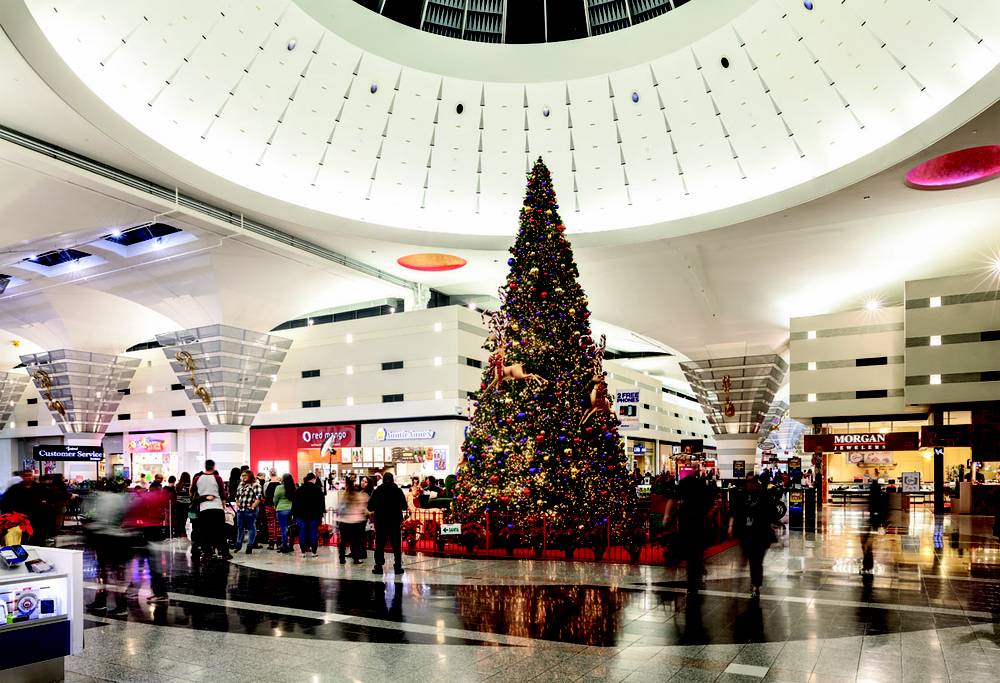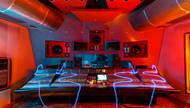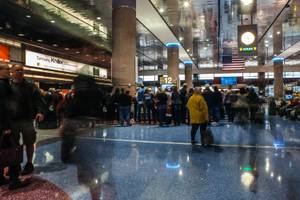"May I help you find something, sir?”
The security guard walks up to me as I peruse a map that appears to be outdated. (He tells me as much.) I explain that I’m just getting a sense of where things are. Though I frequent the Macy’s behind us and Olivia’s Mexican Restaurant Mariscos & Bar, I haven’t actually been inside the Boulevard Mall proper in about 18 months.
It’s a quiet Monday afternoon. There’s only a handful of people visible at a time anywhere in the mall, unlike the Black Friday bustle inside Macy’s just a few days earlier. I don’t recognize many of the businesses; a few storefronts aren’t even illuminated or open. An alarm goes off, a recorded voice asks us for our attention—and then nothing, as the alarm continues. I pass a lonely Santa and a bored toy train ride operator in the center concourse three times. It’s like the Island of Misfit Toys, Vegas edition.
And yet, the Boulevard’s charm reveals itself at all corners. The security guard updates me on the mall’s latest additions and their locations. Another smiles at me as I pass. A clerk at Lids goes the extra distance to find the last Ballcap Buddy cap washer frame and orders me a hat I’ve had trouble finding at other locations. The scribbled sign outside Olivia’s all but smirks at me—“Buy two drinks and pay for them both”—and inside, a server speedily delivers my favorite new dish anywhere, the perfectly cooked grilled octopus las brazas. A group of schoolchildren breeze in and enjoy a friendly back-and-forth with two kiosk operators.
Later, as I scan the area around the recently opened SeaQuest aquarium, someone in a collegiate hoodie and skinny jeans approaches me, smiles and, like the security guard from 90 minutes earlier, asks if I need help finding something. Unlike that security guard, this person isn’t a mall employee.
Would that have happened at Downtown Summerlin?
*****
This is not the Boulevard of old. It’s not even the Boulevard of two years ago. Las Vegas’ original mall has gone through numerous changes, the most necessary of which might have come in November 2013, when developer Sansone Companies acquired about two-thirds of the mall (department-store anchors Macy’s, Sears and JCPenney’s own their buildings and are mall partners with Sansone under a Reciprocal Easement Agreement). Sansone made its intentions clear from the beginning: to revitalize the property and add non-retail offerings, but also to ensure that it appealed to the large Latino population in its vicinity. It has done all that.
“Our original vision was pretty broad,” says Timo Kuusela, vice president and general manager of Sansone Companies. “We wanted big, quality tenants and to clean up the mall and make it look better, and to have an entertainment component. But it has evolved as we have gone through the process.”
They immediately spent millions rejuvenating both the property’s outside and inside, from lighting and landscaping to general aesthetics. They added amenities like free wifi, and modernized the furniture. As they beautified the Boulevard, they reassured tenants, many of whom were disillusioned with the mall’s previous owner.
“If we had been a different company, three-fourths of existing tenants would have vacated already,” Kuusela says. “But we put our arms around [the mall] and got everyone back to profitability and got leases renewed.”
New leases were signed, too. Last November, the 11th (and first Nevada-based) John’s Incredible Pizza Co.—imagine a Dave & Buster’s with rides and more children—arrived, then quickly outgrossed the Knott’s Berry Farm-adjacent John’s outpost and became the company’s No. 1 location.
The food court now reflects the area’s diverse population. No less than three of the tenants serve Mexican favorites, and another, P Dub’s BBQ, offers soul-food fare traditional to African-Americans. Outside the Boulevard, the area’s large Filipino population now has 99 Ranch Market, a major national Asian supermarket that took the building once occupied by Dillard’s. A few doors up sits Goodwill, the first ever to open inside a shopping mall, with a career center to augment its appeal to the largely middle-class community.
Kuusela says Olivia’s is the mall’s first sit-down restaurant, and that its second, Hatari Restaurant & Sports Bar—which will include a tandoor oven, 99-cent beer and live entertainment—should open later this month.
Then there’s the family bait. A 5D simulator and blacklit mini-golf attraction debuted earlier this year. The 31,000-square foot SeaQuest Aquarium just opened. Across from that, a kids’ interactive play area is forthcoming, which might feature trampolines, bumper cars, laser tag and/or climbing walls. And just north of that, a cineplex will be built during most of next year. It’ll be a luxury movie theater, because, as Kuusela puts it, Sansone wants to upgrade the Boulevard experience. “People have the perception it’s a class C mall, and we want to blow that out of the water.”
*****
“That mall is ghetto.”
For as long as I’ve lived in Las Vegas, I’ve heard this sentiment about the Boulevard Mall, and it has only intensified the past few years.
According to Sara C. VanderHaagen, a UNLV assistant professor of communication studies who lives just north of the Boulevard, the word ghetto—originally used to describe parts of a city ethnic minorities were forced to occupy—can implicate any number of things, including location, deteriorating condition and a person or place’s economic status or ethnic background. And yet, it cannot be detached from its racial origins, thus making its use problematic.
“Someone may not be a racist, but that doesn’t mean the term [“ghetto”] doesn’t participate in a broader set of terms and language system in the U.S. that is linked to institutional racism and systemic oppression, and sometimes with regards to race and class.”
VanderHaagen says she hasn’t heard anyone explicitly refer to the mall as “ghetto,” but acknowledges the general area gets maligned by her students. “I’ve definitely heard from people that that is the perception, and you get this from reading posts on Facebook and local publications.”
The Boulevard shares a general vicinity with other retail centers, office/medical buildings, older suburban neighborhoods, a country club and the mid-modern Paradise Palms, Las Vegas’ first master-planned community, which remains one of the Valley’s hottest real estate markets. It also sits a few blocks east of a multi-ethnic South Central neighborhood bisected by Twain Avenue that has historically endured high rates of violence and theft. When the Review-Journal reports crime in the area, it often inserts “near Boulevard Mall” in the headline, which undoubtedly scares off potential customers.
“There’s a sense—and this is an observation by others, not my idea—of possible contamination, that the area’s crime would cross over,” VanderHaagen says. “Those things can get associated by adjacent spaces.”
But the mall is neither in a so-called ghetto, nor is it a hotbed of crime. Metro Capt. Jim Seebock tells the Weekly that one of his sergeants advised the Boulevard’s security team, which then increased lighting, swapped out foliage for more open, desert-like landscaping and added security personnel and patrols throughout the property. “That assisted in our crime prevention efforts in general, and increased safety in the area,” he says. The results: Crime has notably declined at and near the shopping complex over the past three years.
In a statement released last month, Seebock made this proclamation: “Today, the Boulevard is showing to be one of the safest malls in Southern Nevada.”
*****
Even with aesthetic enhancements, demographic-spanning amenities and heightened surveillance, the Boulevard still has its work cut out to once again become the beacon of its community.
Malls geared toward the middle class are struggling and shuttering across the country, says Dr. Gillian Naylor, a marketing and international business department professor at UNLV’s Lee Business School who teaches and studies retailing. “They’re not evolving—they’re going nonexistent.”
Reasons for their downturn abound: escalating overhead costs, online shopping and shifting consumer preferences that show an inclination toward convenience. Even those looking for bargains tend to prefer outlets and clearance emporiums like Marshalls (a Boulevard neighbor) over the formerly thriving Sears and JCPenney (Boulevard anchor stores). “It’s slightly lower-quality merchandise, but people want the brands,” Naylor says, who also adds that a new Boulevard heavyweight, Goodwill, is “popping up everywhere. Millennials love to repurpose. They’re all about that.”
For malls to survive, they must transcend their original retail goals and boast more experiential offerings. The Boulevard has embraced this philosophy, eager to keep people longer and draw families; it’s even marketing to tourists who might want to treat their kids to the type of suburban diversions they recognize, such as John’s Incredible Pizza. Naylor argues otherwise, maintaining that the Boulevard can’t compete with the higher-end Fashion Show Mall, and that people nowadays shop close to wherever they are. “People aren’t going to drive out of their way, or come from the Strip. Locals out in the ’burbs have nicer alternatives. So [the customer base] has got to be locals in the immediate area.”
Like VanderHaagen, who regularly visits the Boulevard and anticipates taking her daughters to SeaQuest. “I’d be interested in having more amenities in our area,” she says. “I think the redevelopment of the mall is a good thing.”
Speaking of redevelopment, the future of the Boulevard might hinge not just on drawing the nearby community and families, but on the potential revitalization of Maryland Parkway. Despite having bought the Boulevard before such talk was rampant, Sansone also has high hopes light rail transportation on the thoroughfare will come to fruition. For right smack in the middle of the route—connected to Downtown and UNLV—lies a local shopping institution, reborn again.





